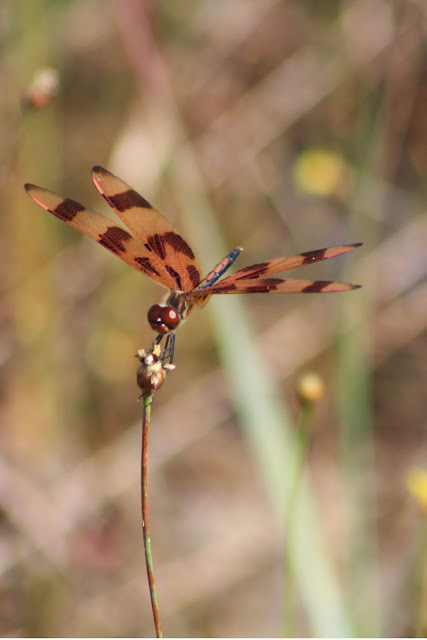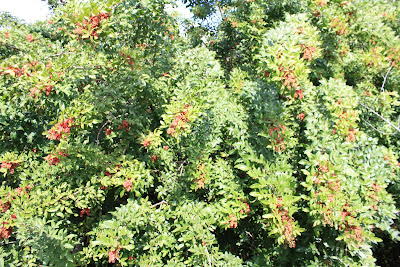One of my favorite things to watch is dragonflies! The species seen here is the Halloween Pennant dragonfly. It is so named for its orange and black (or brown) wings. They tend to be locally abundant, especially in areas like lakes, ponds, and marshes that have emergent vegetation. If not fluttering around, I often see them atop tall grasses and other vegetation along the edges of the water. Like other dragonflies they forage on smaller insects like mosquitoes (YEAH!), ants, flies, etc. The females lay eggs and once these eggs hatch the larvae are known as "nymphs". And interestingly, the longest stage of the dragonfly life cycle is the nymph stage! The nymphs forage on mosquito larvae and other invertebrates.
Panther Island Adventures!
Panther Island is 2,800 acres of restored wetland and upland habitats situated in the northwest corner of Corkscrew Swamp Sanctuary's 13,000 acres. It is home to numerous plants and animals including the Florida panther and the iconic wood stork.
The views expressed in user comments do not reflect the views of Audubon. Audubon does not participate in political campaigns, nor do we support or oppose candidates.
The views expressed in user comments do not reflect the views of Audubon. Audubon does not participate in political campaigns, nor do we support or oppose candidates.
Tuesday, November 30, 2010
Monday, November 22, 2010
Plant of the Week: Brazilian Pepper (Invasive Exotic! BAD!)
Brazilian pepper (Schinus terebinthifolius) is an extremely problematic non-native invasive shrub or tree that is invading natural areas to the point that it disrupts the native communities. This plant is native to Argentina, Paraguay, and Brazil. It was introduced into the United States as an ornamental back in the 1840s. It can invade numerous habitat types including pinelands, hardwood hammocks, cypress, and even mangrove forests. It tends to form dense thickets; these thickets don't allow much light to penetrate so numerous natives can't grow or are displaced.
This plant has been seen flowering throughout the year in Florida, but the most intense period of flowering is in the fall (between September and November). It is readily spread by wildlife that forage on its bright red berries. It is very resilient and can re-sprout readily from the trunk, making it ever harder to eradicate. A relative of poison ivy, it produces chemicals that can irritate people's skin and respiratory systems.Wednesday, November 17, 2010
Coming Soon! ... Habitat and Invasive Plants of the Week!
So yet again I have decided to incorporate more entities to highlight on my blog. So I am going to "mix" in some information about different habitats found on Panther Island as well as teach you about the nasty non-native invasive plants that we work to remove and control plus some of the techniques used (like "fire... fire").
STAY TUNED!
Monday, November 8, 2010
Critter of the Week: Seminole bat (Lasiurus seminolus)
One of my all time favorite animals is the Seminole bat (Lasiurus seminolus) . A member of the Vespertilionidae family, these bats are solitary roosters that often use pine trees or Spanish moss for roosts. The rich mahogany color of their fur with its white tips is great camouflage, and when one hangs from a single foot in a tree they look like a dead leaf! There are also often white patches at the wrists and shoulders. These bats are found throughout Florida (except the Keys), up to North Carolina, and along the Gulf to eastern Texas.
Seminole bats are medium-sized. They have wingspans from 11-13 inches and weigh 9-14 grams. Just for comparison, a US minted nickel weighs exactly 5 grams! These bats forage on insects such as moths, beetles, flies, and more. Females give birth to 1 to 4 young but in Florida it is typically 3 or 4 pups, born in mid-May to mid-June. These pups will take their first flights when they reach 3 to 4 weeks old.
For more information visit these websites:
Florida Bat Conservancy
Bat Conservation International
Monday, November 1, 2010
Critter of the Week: Red-shouldered Hawk
One of my favorite birds is also one of Panther Island's most common, the red-shouldered hawk (Buteo lineatus). These vocal raptors feed primarily on small mammals, amphibians, reptiles, and birds, often going after the more sluggish and therefore more easily captured prey. While they prefer hunting from They prefer woodland habitats near water. They typically nest in large mature trees that have good canopy cover. Nests themselves are large bowls made of sticks, bark, dried leaves, Spanish moss, and lichens and also line their nests with Spanish moss, lichen, and fine bark. Clutch sizes range from 2-5 eggs, and the eggs hatch after approximately 33 days. An interesting tidbit is that by 5 days old, the young birds are able to shoot their feces over the edge of the nest! So if there is a nest around, look for bird guano on the ground to see if it is active.
There are actually 5 subspecies of red-shouldered hawk. The four eastern forms have ranges that abutt, but the western form is separated by 1000 miles from the "easterns". Two of the 4 subspecies breed in Florida. From the panhandle to Lake Okeechobee is Buteo lineatus alleni. In southern Florida and the Keys, Buteo lineatus extimus ( which is smaller and paler) breeds. When identifying these birds in flight, look for distinctive pal translucent crescents across the outer primaries.
There are actually 5 subspecies of red-shouldered hawk. The four eastern forms have ranges that abutt, but the western form is separated by 1000 miles from the "easterns". Two of the 4 subspecies breed in Florida. From the panhandle to Lake Okeechobee is Buteo lineatus alleni. In southern Florida and the Keys, Buteo lineatus extimus ( which is smaller and paler) breeds. When identifying these birds in flight, look for distinctive pal translucent crescents across the outer primaries.
Subscribe to:
Posts (Atom)







